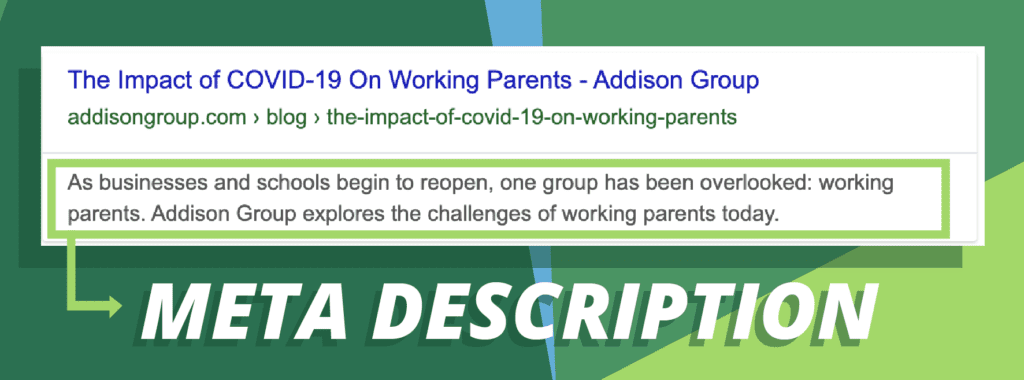Top 5 Digital Marketing Trends for 2021

With 2020 — the year that seemed like it would never end — finally wrapping up, now is the perfect time to set your sights on 2021. Digital marketing, by nature, has always been a dynamic industry to work in. The minute you catch up with one trend, a new best practice is revealed, or Google decides to adjust one of their algorithms, or an entirely new social channel emerges. Keeping up with the latest in digital marketing can be a full-time job itself. Don’t sweat it though — we’ve put together a list of the top five digital marketing trends you’ll need to stay on top of to succeed in 2021!
Follow our guide below to be sure you’re one step ahead of your competition, and reach out to an Addison Group professional to support your digital marketing staffing and consulting needs!
No-Click Searches
Lately, the number of “no-click searches” has increased almost exponentially. So, what exactly is a no-click search? It’s just what it sounds like! A user types their search query and is presented with a suitable answer directly within the SERP (search engine results pages), without having to click and navigate to the actual site.
The increased popularity of this type of search is largely due to the expanding emphasis on meta-descriptions for SEO. More and more marketers are taking advantage of the valuable space meta-descriptions provide. Google also collects answers to common questions in a search, leading to even more people executing no-click searches. In fact, results gathered in a recent analysis of Google clickstream data, with over 1 billion data points, found that 49% of all searches are no-click searches.

This might seem counter-intuitive. You’re producing content, but not getting any clicks from it, so what gives? Why would Google make it easier for people to never visit your website? That’s for them to answer, but it’s not all bad!
Having your page and your content appear in a no-click search proves to not only those searching, but to Google as well, that you provide valuable content. You answer questions that people need answers to. Over time, this can help boost your SEO rankings with Google, who will credit your site for having valuable content, and will also build a relationship with your audience. They will come to rely on your content for valuable information, which is critical in brand building and thought leadership.
While it may seem like another hurdle to jump over in your quest for marketing conversions, do not discount the value no-click searches will provide you in 2021.
Voice Search
Voice-activated digital assistants are commonplace right now. Wherever you are, shout “Hey Siri,” “Ok, Google,” or “Alexa.” With around 3.25 billion of these devices being used daily, we’d bet at least one device answered your call.
Like many digital marketing trends we’ve identified for 2021, voice searches have had a meteoric rise, with only 2% of digital workers using digital voice in 2019, and an expected 25% of them doing so in 2021. Sectors like healthcare, remote diagnostics, and elder-care applications will use voice search functionality for ease of use, but the opportunities are endless.
When considering SEO tactics for 2021, be sure to optimize for voice searches, or risk falling behind those who do. Restructure some of your content to be more conversational, and follow the flow of spoken versus written word.
Think about what type of content people are using voice searches for. In general, they’re quick, short questions asked on the go. Contact information, location addresses, and your FAQs are all great places to begin optimizing for voice, but you know your content and target audience best, so explore all of your options.
Page Speed
While page speed has always been a critical KPI to track, many companies overlook it. Despite this though, a slow loading page is the number one contributing factor to bounce rate, the percentage of visitors who leave your site per page.
Not only is a slow loading page frustrating, but it is also detrimental to your SEO score within search engines. That’s right — Google tracks how long your pages take to load. If yours are too slow, they won’t show up above the fold on the results page, and you won’t get any website visitors.
A number of different factors can influence your page speed. The size of photos or videos on the page, the number of redirects within the page, how long the page is, and the number of links on the page are some of the factors to begin with. In general, the simpler and smaller your page is, the faster it will load. Of course, you cannot (and should not) completely sanitize your site of photos or videos. Instead, weigh your options and your pros and cons. Can you make that video or photo smaller? If not, what purpose does it serve? If you think a particular element is valuable to your site, then, by all means, keep it.
Ad Blockers
For consumers, ad blockers are a nearly ubiquitous and wholly loved tool. For marketers, they’re the worst. Though they’ve been around for years, recent changes to the accessibility of ad blockers (they’re now considered more legitimate or safe and are cheaper or even free to use), their popularity is growing.
Ad blocker use is expected to peak at 27% of all internet users in 2021. Users 18-24 will have adopted ad blockers more than any other age group, at a rate of 41%.
If you run any sort of ad campaign and the users you are trying to target have an ad blocker installed, your ads won’t show up. There are no secrets or tricks to “beat ad blockers” so all marketers are able to do is adapt and respond. If you notice that a significant proportion of your target audience utilizes ad blockers, shift your campaign and budget. Invest more in other types of marketing they are likely to consume. For example, 18-24-year-olds use ad blockers more than any other age group, but are also very engaged by influencer marketing on social media. Look into your own target audience and determine other tactics to reach them besides using paid search.

Greater Emphasis on Local SEO
Digital marketing is as competitive as ever. Take a look at any keyword research tool (we’re partial to SEMrush, but there are plenty of options out there!) and notice how high some of the metrics are. Keyword difficulty (how hard it is to rank for a keyword both organically and through a paid campaign), keyword competition (how hard it is to outrank your competitors for a paid keyword), CPC (cost per click), and other key metrics are all trending upwards.
The fact of the matter is, organic growth is even slower and even harder now, and the oversaturation of competition in paid campaigns can be a huge barrier to many organizations. Without a truly massive paid search budget, you probably don’t see the return on investment that you’d like to.
Redirect your energy (and more importantly, your budget) to local SEO efforts instead. Longer, geographical keywords (for example, “Chicago Staffing firms” as opposed to just “staffing firms”) are more likely to be seen by your target audience anyway. These keywords are also typically more affordable and easier to rank for, both organically and in paid search. What’s more, the more targeted your keywords are, the more valuable those leads will be. More specific searches imply a higher intent to convert, so capture as many of those leads as you can.
How Addison Group Can Help
At Addison Group, we know the importance of finding the right people to do the job. In fact, finding a perfect match is what we’re known for. We also know exactly how hard and time consuming that can be.
Whether you’re a hiring manager looking to add top talent to your marketing team, or you’re a marketer yourself looking for a place to call home, contact an Addison Group professional to find your perfect match today.
Sources
“2020’s Voice Search Stats – Is Voice Search Growing?” Review42, 2 Oct. 2020.
Fishkin, Rand. “How Much of Google’s Search Traffic Is Left for Anyone But Themselves?” SparkToro, 18 June 2019.
“How To Prepare for Digital Marketing in 2021: JUST™ Creative.” JUST, 1 Oct. 2020.




